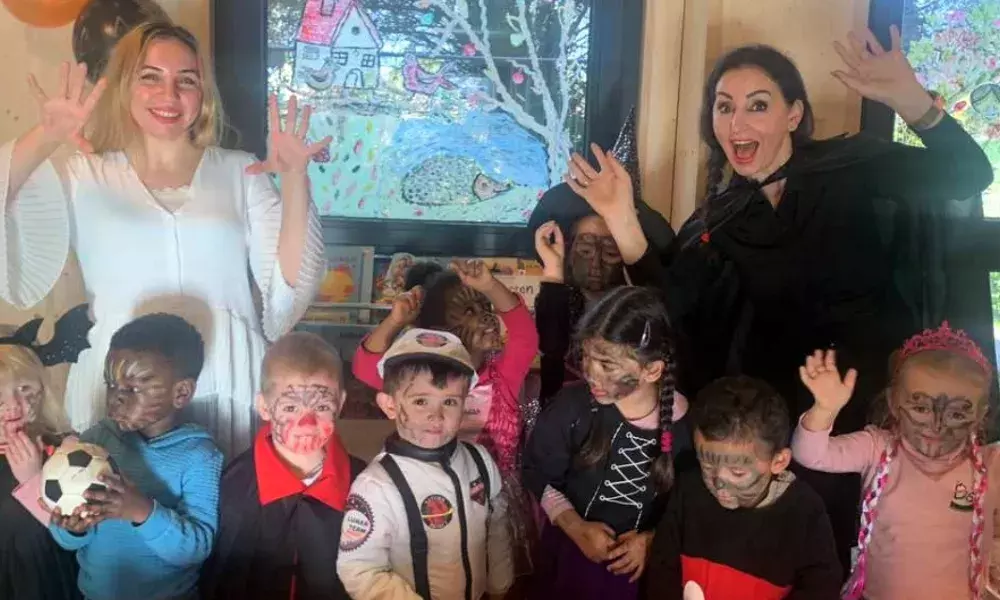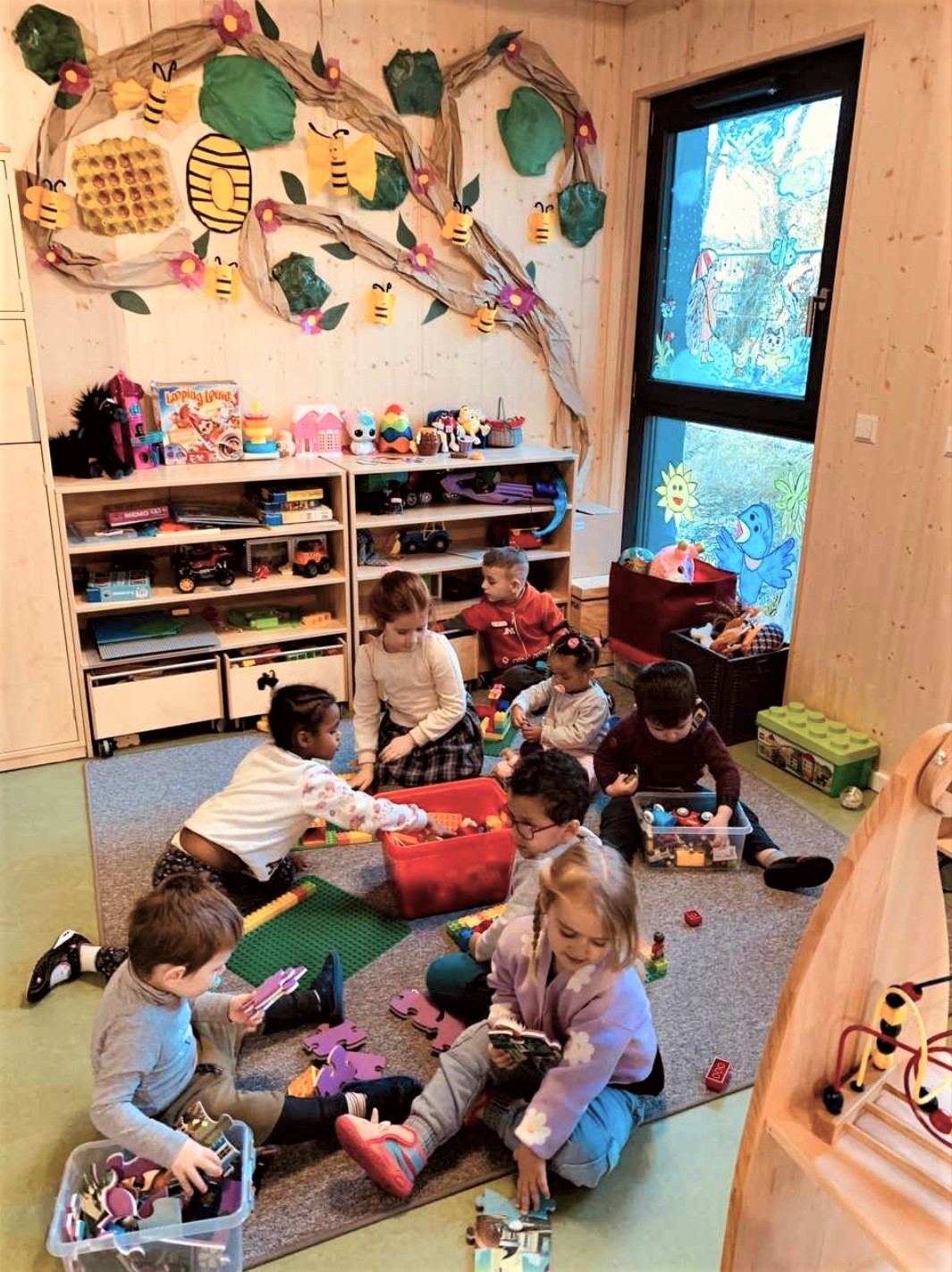Zoom In 2: First experiences from living together in the home and care house

The home and care project aims to contribute to the sustainable social and financial stability of single parents and their children in Landshut. In particular, health and care professions, which require special time flexibility, present single parents with the difficulty of balancing the organization of family life with work life. To tackle this challenge, the project built a house with on-site daycare beyond opening hours of regular daycare centers and apartments for single parents. The combination of daycare, living together and working in care also comes with challenges for those who now spend their daily lives together in the home and care house. The project puts special effort in making the co-living a success and overcoming obstacles that arise. This Zoom In provides an initial interim summary of these experiences.
The co-living of residents and their children in the home and care project functions in a pleasingly harmonious manner, with just a few exceptions. The majority of women who moved in at the opening of the house already knew each other very well from the meetings that took place in the course of the selection process of residents. They soon successfully built on these relationships and improved their social interaction with each other. As a result, sympathies and in some cases even friendships, were able to develop between the new neighbours or the users of the day care center.
The women organize their own excursions, for example to the nearby adventure playground or for a walk in the evening. The so-called "little forest" has been very well received, which is a child-proof fenced-in area on the property with many trees and shrubs, some of them tall, and a large picnic bench. The space, which is very close to nature, provides the ideal location for summer weather, for example, for children's birthday parties or playdates, and is frequently used, including, of course, by the childminders from daycare centers. Friendships have already formed between children from the neighbourhood and home and care children.
In order to build relationships between residents who might otherwise not meet, regular joint activities for mothers and children are organized by the Children's Foundation. For example, a large St. Martin's procession was organised in cooperation with the daycare centers as well as a Christmas party and a joint visit to Christkindlmarkt.
The women were actively involved in the design of the “little forest”. In this context, a day of action should be mentioned, on which anyone who had time helped to clear the open area in the forest from bad weeds. Project Partner ZAK e.V. regularly offers puppet theatre for its large day care centers for example the fairy tale "The Wolf and the Seven Little Goats". The performance is followed by a snack for the children of home and care.

One goal in the work with the residents is to help them to help themselves and not to let them fall into a learned helplessness. Thus, the approach to any individual or collective problem has always been to intervene only when they really cannot find a solution among themselves.
In order to promote this principle of self-governance, it was decided together with the residents that two so-called house leaders would be elected who would be the first point of contact in the event of any problem. If individual problems cannot be solved independently, they forward the request. An example of a problem that the residents have solved independently is the formulation of house rules. At their own request, a short set of house rules has been drawn up to which everyone adheres. The house rules concern, for example, quiet times, the closing of jointly-used doors, or the tidying up of toys after children play in common areas by the respective mothers. At the beginning of the process, there was a great deal of disagreement. Some women felt disadvantaged because they felt their opinions were not being taken into account. Other mothers refused to accept the agreed-on rest periods. Over time and through discussion among themselves, the women were able to come to an agreement and finally found a solution that was satisfactory for all and that is for the most part now followed. This led to the realization that satisfaction for all can only be achieved through more togetherness. The social actors involved deliberately refrained from exerting any influence in order to create opportunities for the residents to empower themselves and to avoid that they rely too much on external parties instead of taking an active part in finding solutions.
In some cases, it was necessary to intervene in personal conflicts between residents. Two residential partners could not agree on the care times for the caregiver's children. The childminder felt that she was being taken advantage of by the caregiver because the latter repeatedly wanted to change the contractually agreed care hours at short notice and, in some cases, extend them. The caregiver, on the other hand, had accepted a new job as soon as she moved in, which she valued highly and was very keen to meet the demands. Thus, she sometimes felt obliged to cover shifts at short notice, even if this was not directly requested of her. The mother hoped for spontaneous support from the childminder. They clashed again and again, and the argument became more and more heated. Consequently, the Children's Foundation offered both women several mediation sessions. Over time and with support, the potential for conflict diminished and they became closer again.
One of the biggest challenges in living together is coordinating the care times of the children of the residents working in the care sector. In order to be able to ensure this, a special working model for the single parents was developed with the care employers involved in the project. This allows them to work regular early shifts and additionally every second weekend, with Wednesdays remaining free. In the early morning hours and on Sundays, the children can thus be cared for by the childminder or residential partner, while the daycare center takes over the rest of the time.
This model guarantees the children a certain routine, it does not overload either the caregiver or the daycare mother and has proven itself. It always becomes difficult when a caregiver does not want to work in this model. This can be for various reasons. For example, the mother may be on a training course, which entails different work and school schedules. Or the mother may have another employer who cannot or does not want to offer the working hours that were agreed in the project.
In addition, the project offers both the residents and the childminders who work in the daycare centers the opportunity to receive further training as childcare workers or educators, for example through the project’s partnership with the Seligenthal Technical Academy. Of course, further training ties up the childminders' time, which makes it even more difficult to coordinate care times.
The coordination issues led to the feeling that more flexible thinking is needed in the project with regard to the care concept in the future. Ultimately, the above model serves as a basic framework. Based on this, it must be determined with each caregiver individually at what times childcare is needed, which is then provided via the residential partner and daycare center. In addition, the project tries to encourage the women to help each other out as part of the neighbourhood support system when unforeseen appointments make care at short notice necessary. Regardless of which side they are on it is encouraging that this works so well. For example, a resident from the care unit voluntarily took care of another caregiver's daughter when she had to study for her final exams, or a childminder regularly helps to cook lunch for the (older) neighbour's child when the mother is at work.
In order to promote harmonious coexistence in the house, it is important to closely monitor changes of the residents. All residents were made aware that they would have a say in the selection of a new neighbour. If the Children's Foundation considers a new tenant to be suitable, all parties involved take part in a joint meeting with the children. In this context, both parties introduce themselves, talk about their lives and why they would like to participate in the project. If the conversation is harmonious, the participants exchange their contact details and are encouraged to meet regularly, if possible, with the children, e.g., for ice cream or at the playground. The next tenant will only receive an offer if the existing party gives their consent.
With the aim of obtaining further outside support for living together, the Children's Foundation and the City of Landshut entered into a cooperation with Fala (Landshut Volunteer Agency). This agency coordinates volunteers in the city in various projects. So far, two volunteers have been found who come to the day care center every week as part of the "German for Little Ones" program and practise speaking German with individual children in a targeted and playful manner. In view of the high proportion of children whose parents do not have German as their mother tongue, this is a great benefit.
In conclusion, it can be said that the concept of living and working together is working. However, it will only work if it continues to be possible to react in a flexible manner to new needs and if residents are encouraged to solve their own challenges. The supporting professionals see themselves more as contact persons who provide opportunities for communicative exchange, who moderate and mediate only when necessary. Under no circumstances should they create solutions or give instructions that affect the living together. Only by strengthening the role of the residents co-living can be made possible on the long term and satisfaction ensured.
For coordination, the process means constantly questioning one's own role, working out and evaluating the success factors, and learning from obstacles that arise in everyday life in the home and care house. In the implementation of the concept, this is therefore a learning by doing process with critical self-reflection and a slow development towards a routine in living together. Without the satisfaction and the togetherness of the residents, it is difficult to achieve progress in the joint implementation of childcare and joint employment. In this respect, cohabitation in general is key to the functioning of the home and care project.
About this resource
The Urban Innovative Actions (UIA) is a European Union initiative that provided funding to urban areas across Europe to test new and unproven solutions to urban challenges. The initiative had a total ERDF budget of €372 million for 2014-2020.
Similar content




